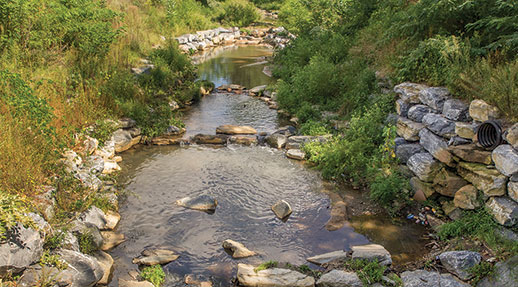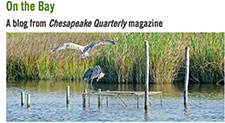|
April 2015 • Volume 14, Number 1

Photograph by David Harp
|
Jeffrey Brainard
Will restoring streams in the Chesapeake watershed improve water quality in the Bay? The question has become a focus for researchers working on stream restoration, a fairly young science, now barely two decades old. As is often the case in science, the early answers only raised new questions. For one project, contractors reshaped the channel of a stream called the North Cypress Branch, hoping to slow the flow of water surges during storms. They cut down trees, widened the stream to 50 yards in places, and carved out a series of shallow pools. Would the redesign reduce erosion? If so, by how much? Would it reduce the flow of pollutants that usually attach to sediments? Searching for hard data, researchers are monitoring a series of restoration projects similar to the one at North Cypress Branch. more . . .
|

To protect streams flowing down towards the Chesapeake Bay, geologist Andrew Elmore and his colleagues hiked up to Maryland's mountain tops. Again and again, in dozens of Maryland forests. All their hiking and bushwhacking helped them build a novel, detailed map documenting Maryland streams not recorded on other maps. The end result was a computer model that predicts the locations of small streams that interlace the state west of the Bay. The model offers a tool to protect streams from development and to improve the region's water quality. more . . .
|

Watershed restoration specialists with Maryland Sea Grant are pilot testing a new app for mapping citizen efforts to clean up local waterways. They call the app the SMART tool, shorthand for the Stormwater Management and Restoration Tracker. They hope the tool will help the state meet mandated goals for cleaning up the Bay. more . . .
|

Three Maryland graduate students are employing their scientific knowledge this year to help the federal government develop marine policy. All three Knauss Marine Policy Fellows are working for the National Oceanic and Atmospheric Administration (NOAA) in the Washington, D.C. area. more . . .
|

At the end of March, a new blog called On the Bay was launched as a service from Maryland Sea Grant and Chesapeake Quarterly magazine. Posts will include short essays, slide shows, podcasts, occasional videos, and frequent reporting on marine and environmental issues. From time to time we will carry guest-written posts contributed by those with Bay memories to share and by those engaged in studying, managing, or protecting the Chesapeake Bay's ecosystem. You can read On the Bay at: www.mdsg.umd.edu/onthebay-blog
|
|
Typically, oceanographers look to the sea, but those who study the Chesapeake Bay have to also look to the land. How does the flow of water and earth coming off the watershed affect conditions in the Chesapeake?
In This Issue. . .
Related Links
|